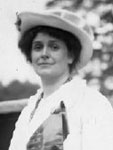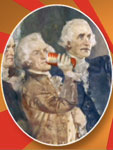Hope for America

Hope for America, an exhibition from the U.S. Library of Congress, focuses on the comedian Bob Hope and the marriage between humor, politics, and satire in the modern age. Various viewpoints are on display, which the site believes will allow visitors "...to draw their own conclusions regarding the interplay of politics and entertainment in American public life and its consequences for the nation’s political culture."
The site is divided into three basic themes: Political Humor, Causes and Controversies, and Blurring of the Lines. Each thematic section offers a basic overview, some poignant quotes, and links to items in the collection. A bibliography and list of events are also provided for further exploration in the top navigation menu.
It is worth noting that each of the three main thematic sections contain between seven to nine subsections. Users can choose to view the entire set of items in the three main sections, or by each subsection. In all, around 180 items are available for U.S. history teachers and students. Each item contains a brief description and most images can be viewed in larger sizes and/or downloaded for educational use.
This collection by the Library of Congress is highly recommended for educators and students of American history who want to gain a better understanding of the historical relationship between politics and comedy. Although Bob Hope is the center of the exhibit, comedians and satirists throughout the twentieth century are included. The scope of the exhibit, largely covering the entire twentieth century, is likewise helpful in understanding how humor and political concerns changed over time.
Ballyhoo!: Posters as Portraiture

Ballyhoo! presents a concise history of advertising posters and their use of celebrity in the United States, as well as the export of U.S. celebrity to other countries. The website was initially created as an accompaniment to a National Portrait Gallery exhibit which ran in 2008 through 2009.
The site is broken down into an introduction and eight short explanatory sections, each with a two-paragraph essay and four to eight related posters to view.
Sewall-Belmont House Museum Collections

The Sewall-Belmont House is a National Woman's Party-run museum on women's equality movements in the U.S. A portion of their collections are now searchable online.
Using the site's search engine, you can easily find printing blocks for the newspaper the Suffragist, as well as cartoons by Nina Allender. Other items may be a bit more difficult to find, but the collection includes keys, voting cards, a jail door pin (worn by suffragists jailed for their activism), and more.
If you aren't sure what to look for, try either Click and Search or a selection of Random Images. Each time you access the images, a different set will be pulled from the collection. As for "click and search," you can choose a letter for any of an object's data fields (object type, creator, subject, etc.), and browse through corresponding drop-down lists. Select anything that catches your eye, and the site will bring you to that particular artifact's page.
Among these three ways of accessing the site content, you should be able to uncover a treasure trove of women's rights sources to share with your classroom.
Center on Congress

The Center on Congress, led by former U.S. Representative Lee Hamilton, exists to help the public better understand the role of Congress and the public's relationship to it. Their audience includes the general public, teachers, and journalists.
Your first thought as an educator may be to click on Teacher Resources. However, this section is more of a gateway to content in Learn About Congress than a section unto itself. That said, Classroom Resources does include a tool for paring down the site's educational materials to the appropriate grade level and topic, as well as best practices videos of lessons in action.
Learning About Congress has the widest variety of content useful to the K-12 educator. Resources include approximately 8 interactive modules, more than 20 short animated videos, a collection of live-action video clips of "insider views," more than 30 brief audio presentations on issues ranging from disaster relief to bilingual education, and a variety of relevant reading material. The spoken narration on the interactive modules tends to be dry, and would more than likely only be of use in the higher grades. However, the animated videos are enthusiastically narrated, making them more appropriate for a wider range of viewers. A free Citizen's Guide helps to connect daily life to the actions of Congress. The guide is not unlike a textbook in terms of language and graphic design. As such, its format should be readily accessible and familiar to the average student.
Depending on your computer access and comfort with online activities, you may also be interested in the Virtual Congress where your students can create members of Congress, move their avatars through digital recreations of key locations, and participate in a "multi-player" setting proposing legislation. Another option is Teaching with Primary Sources, a joint effort between the Center on Congress and the Library of Congress, providing separate entry points for teachers and students. These offerings require free registration.
Other items of interest on the site include results of public and political scientists' surveys on Congress' function, beginning in 2002; a blog concerning topics relevant to current Congressional issues; and Congressional FAQs. Teachers can also apply for the American Civic Education Teacher Awards.
Divided Allegiance

How can a person born in the U.S. to one U.S. citizen parent and one non-U.S. citizen parent (divided allegiance) be defined as a 'natural born citizen?'
Shouldn't a 'natural born citizen' be defined as being born with allegiance to the U.S. only?
Throughout the history of the United States, there has been a consistent evolution of who a citizen is and how a citizen is defined, as the United States Constitution has been both decided upon and modified on various occasions to expand the definition of who is a citizen and guarantee equal rights for all individuals. In the late 18th century, a citizen was defined as a white, male landowner, and African Americans could legally be held as slaves. The 1857 Dred Scott v Sandford Supreme Court case affirmed this definition. The Oyez Project (2005–2011) puts forth that in this case the Court found that "no person descended from an American slave had ever been a citizen." Six years subsequent to this decision, President Lincoln issued the Emancipation Proclamation, which declared "that all persons held as slaves within the rebellious states are, and henceforward shall be free."
This change was reflected in the Constitution of the United States in the 14th Amendment (1868), which states "All persons born or naturalized in the United States . . . are citizens of the United States and of the State wherein they reside," as well as the 15th Amendment (1870), which puts forth that "The right of citizens of the United States to vote shall not be denied or abridged by the United States or by any State on account of race, color, or previous condition of servitude." However, the next half century still saw roughly half of the country's population without full citizenship rights, as it was not until 1920 that the 19th Amendment was passed that granted women suffrage. To answer the particular question posed above, simply put, the 14th Amendment guarantees that a person born in the United States is thereby a citizen, even if both parents are illegal immigrants. However, this is not without controversy, and it has become a political issue, as citizens born to illegal immigrants have derisively been referred to as "anchor babies." For more on this issue, try searching the New York Times using the phrase "anchor babies." However, American children of foreign parents can be dual citizens depending in part on the rules of the other country. This status is conferred when "an individual is a citizen of two countries at the same time." The website newcitizen.us describes potential benefits to being a dual citizen; among them are "the privilege of voting in both countries, owning property in both countries, and having government health care in both countries." However, the U.S. Department of State puts forth that the U.S. government "does not encourage" dual citizenship "because of the problems it may cause," particularly that "claims of other countries on dual national U.S. citizens may conflict with U.S. law, and dual nationality may limit U.S. Government efforts to assist citizens abroad." To answer the initial question in regards to allegiance, allegiance may be more the way a person feels rather than actual law. On this topic the U.S. Department of State notes that "where a dual national is located [where the citizen resides] generally has a stronger claim to that person's allegiance."
Newcitizen.us. "Dual citizenship." 2011 (accessed on April 8, 2011).
U.S. Supreme Court Media. "Dred Scott v. Sandford," 60 U.S. 393 (1857). The Oyez Project (accessed on March 31, 2011).
U.S. Department of State. "US Department of State Services Dual Nationality" (accessed on April 8, 2011).
U.S. Immigration Support. "US Dual Citizenship." 2010 (accessed on April 8, 2011).